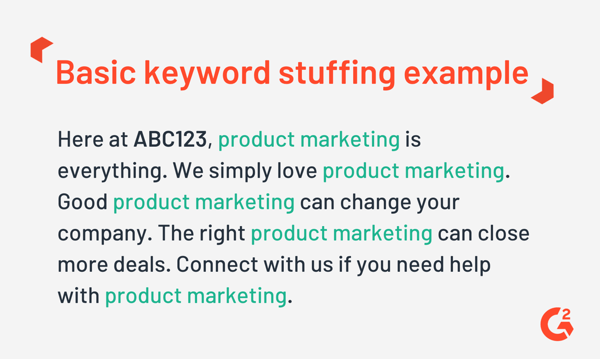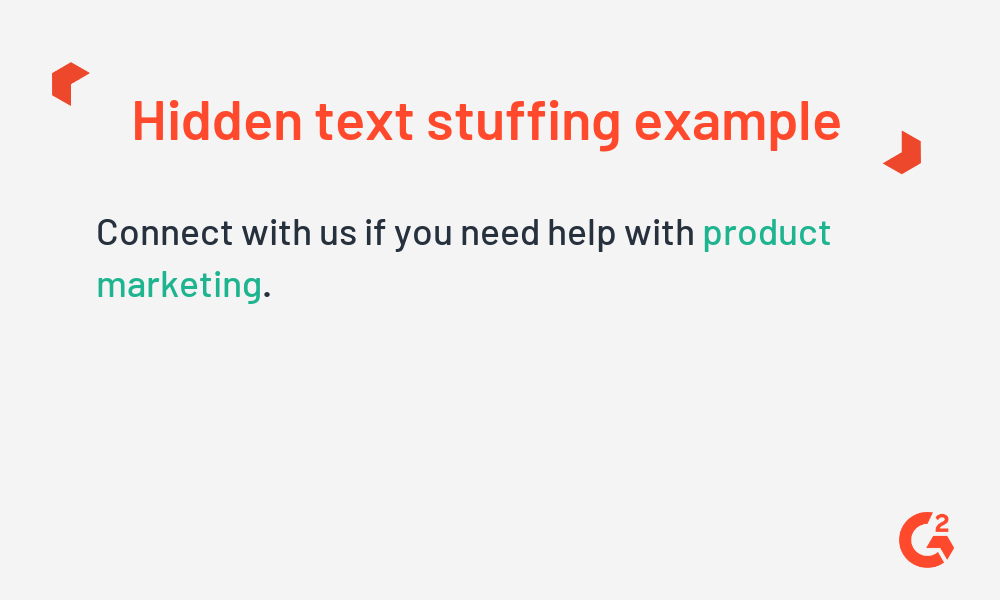If you think repeating the same keywords will help you rank a content piece, you are wrong.
A fundamental part of content marketing, specifically on the writing side, is performing keyword research to target a specific keyword for a blog or webpage and optimizing it for search engine results pages (SERPs).
You can conduct this research using SEO software with keyword research capabilities. These tools show you metrics like keyword volume and ranking difficulty, but they don't always tell you the negative impact of stuffing your content with keywords.
What is keyword stuffing?
Keyword stuffing occurs when you excessively fill a web page, blog, on-page content, page title, meta tags, or meta description with the same keyword phrases. Search engines see this as an attempt to manipulate a page's search results ranking and can penalize or remove the page from SERPs.
Stuffing keywords or adding the same phrases repeatedly is unlikely to help you rank on search engines. It wasn’t long ago when pumping content full of exact match keywords was beneficial and often led to an uptick in search engine rankings. Then, people started using different variations of the primary keyword in on-page copy to rank faster.
Search engines, with updates over the years, have become smarter. Today, they understand keyword stuffing is spammy and affects user experience.
Not all keyword stuffing is deliberate. Webmasters with little knowledge of SEO may be doing it without even knowing.
Types and examples of keyword stuffing
So, are you stuffing keywords in your content today? Check out these types and examples to see what kind of keyword stuffing search engines penalize.
Visible keyword stuffing
Visible or basic keyword stuffing occurs when you unnecessarily repeat target keywords in your content. For example, a web page or blog on product marketing should be cautious of the number of times it uses the term 'product marketing'.

The thought that more keyword density leads to more search engine recognition is outdated and should be taken seriously when writing content.
How to check keyword stuffing
Do a ctrl+f on any web page and enter the keyword you want to check. It shows how many times you have used it. Take the number of times a keyword appears and divide it by the total number of words in the content piece. Keyword density is the result you get. SEO experts believe around 1 to 2% keyword density is ideal.
Invisible keyword stuffing
This type of stuffing is a bit savvier, but still recognizable by search engines when crawling web pages. Hidden text or invisible stuffing uses the same concepts as regular stuffing, instead, a marketer matches the color of the text to the webpage background, essentially making it invisible to the reader.

Webpage text, regardless of its style, size, or color, is still HyperText Markup Language (HTML) that will be found when search engines index your page. You can’t outsmart bots, aka the search engine crawlers.
Tip: Link spam, also known as spamdexing, may not be an outright example of keyword stuffing, but the thought behind the strategy stays the same – stuff content with as many links as possible. Search engines see this as spam and will penalize it accordingly.
If your SEO strategy uses any of these keyword stuffing techniques to influence search rankings, it’s time to hit the drawing board.
Why is keyword stuffing bad?
Trying to please the ranking algorithm with keyword stuffing is a bad idea. Keyword-stuffed content is unreadable and negatively affects user experience. Search engines reward high-quality, in-depth content that answers queries and serves search intent. Repeating primary and secondary keywords may boost keyword density, but won’t necessarily improve a page’s ranking. This is because keyword stuffing:
- Hinders positive customer journeys. Stuffing keywords means you’re writing for search engine optimization, not the readers.
- Attracts penalties. Search engines don’t like black hat SEO techniques like keyword stuffing and may decide to remove your pages or website from the SERP.
- Affects time on page. When you overuse irrelevant keywords in your website content, readers can’t find what they came for and will go elsewhere.
- Hurts brand reputation. Stuffing keywords often leads to readers associating your brand with poor content.
Trying to figure out what to do? Keep reading.
How to avoid keyword stuffing
While there’s not an exact amount of keywords you should look to avoid, there are some ways to be conscious of keyword stuffing.
- Focus on useful, information-rich content. This tip comes directly from Google, the leading search engine today. Focus on creating useful, information-rich content using keywords appropriately and in context. Basically, create content that’s useful to the reader. If you're focusing on hitting excessive keywords instead of creating genuine content, you're probably stuffing.
- Be specific. If you can describe your argument (with your keyword in it) in 150 words or less, then why would you do it in 300? Yes, search engines enjoy longer pieces of content, but not at the expense of keyword stuffing and rephrasing.
- Stay on track with your content. This point relates more to link spamming but also piggybacks off being specific with content. Try to avoid going on tangents and touching on keywords that are irrelevant to the main topic. This could lead to non-deliberate stuffing.
If you want to avoid keyword stuffing, focus on naturally-written text that answers readers’ queries while ensuring readability. Now, let’s look at how to optimize a piece of content for search engines.
How to optimize content better
Quality content with proper keyword optimization is the best way to solve keyword stuffing issues. Take a look at these steps to optimize content with relevant keywords.
- Zero in on single search intent. Try writing a web page with a single keyword in mind and add closely-related search terms. This’ll help search engines get a clear idea of the main topic.
- Maintain a healthy keyword density. Insert the target keyword only where it feels natural. That way, you can optimize content yet prevent keyword-stuffed content.
- Write longer content. It's not necessary for your content to be long to rank, but if it's detailed, then you can sprinkle relevant keywords throughout the piece.
- Use long-tail keywords. Secondary keywords, long-tail variations, and synonyms provide search engines additional context about your topic.
Try tightrope walking
A sense of balance comes from knowing what to hold onto and what to let go of. Finding out whether you've stuffed keywords in your content is the best place to start if you're concerned. Then, maintain keyword density but don’t stuff content with key phrases. That’s the fine line you must walk.
Having a hard time researching keywords? Check out this expert’s guide on conducting keyword research.
 by Craig Gibson
by Craig Gibson
 by Holly Hunt
by Holly Hunt
 by Hailey Friedman
by Hailey Friedman